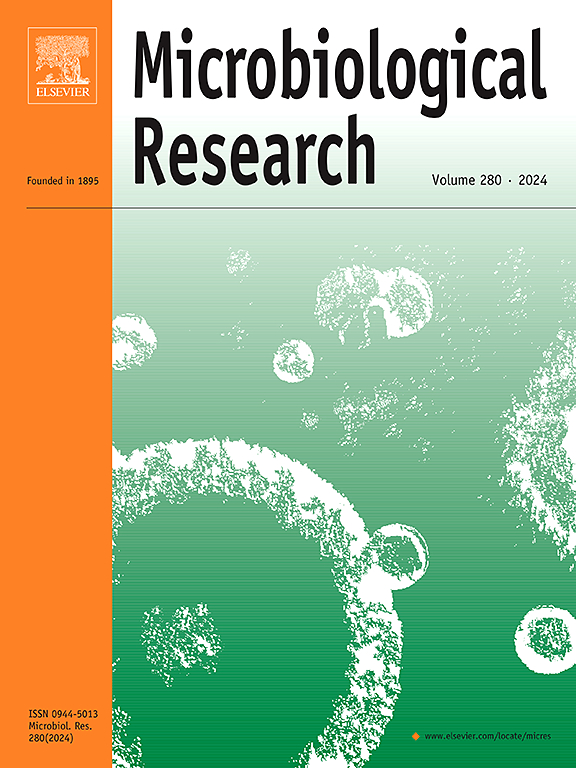森林多样化对亚热带森林土壤功能和微生物群落特征的影响取决于深度。
IF 6.1
1区 生物学
Q1 MICROBIOLOGY
引用次数: 0
摘要
土壤微生物对维持森林生态系统的功能和稳定性至关重要。森林的多样化,如单一林分与混交林分,会对微生物群落的模式和过程以及它们在土壤生态系统多功能性(如亚热带森林生态系统)中的作用产生重大影响。然而,人们对这些模式和过程随土壤深度的变化知之甚少。在此,我们研究了一项为期八年的森林多样化田间试验的结果,比较了亚热带地区混交种植园与单一种植园在垂直剖面(0-80 厘米深)上的土壤生态系统多功能性、细菌和真菌群落组合以及网络模式。我们发现,在针叶树单一栽培中引入阔叶树可增强多种功能之间的协同作用,从而改善土壤的多功能性。混合种植对表层土壤功能潜力的影响大于深层土壤,尤其是对碳降解基因(apu、xylA、cex和glx)的影响。表层土壤,尤其是混合种植园中的土壤,微生物群落的组成主要是随机过程,而深层土壤中的确定性过程则更为重要。混合种植园顶层的土壤微生物网络复杂性和稳定性较高,但深层则为单一种植。有趣的是,表层微生物群落和多功能性的变化主要与养分变化有关,而深层微生物群落和多功能性的变化则更多地受到土壤水分的影响。总之,与单一种植相比,我们发现混交林对土壤微生物特征和功能有积极影响。我们的研究结果强调了通过促进树种多样性来提高功能多样性的重要性,管理者可以更好地制定森林管理策略,以促进全球变化情景下的土壤健康。本文章由计算机程序翻译,如有差异,请以英文原文为准。
Depth-dependent effects of forest diversification on soil functionality and microbial community characteristics in subtropical forests
Soil microbes are critical to the maintenance of forest ecosystem function and stability. Forest diversification, such as monocultures versus mixed forests stands, can strongly influence microbial community patterns and processes, as well as their role in soil ecosystem multifunctionality, such as in subtropical forest ecosystems. However, less is known about these patterns and processes vary with soil depth. Here, we investigated the results of an eight-year forest diversification field experiment comparing the soil ecosystem multifunctionality, bacterial and fungal community assembly, and network patterns in mixed versus monoculture plantations along vertical profiles (0–80 cm depth) in a subtropical region. We found that the introduction of broadleaf trees in coniferous monocultures led to enhanced synergies between multiple functions, thus improving soil multifunctionality. The effects of mixed plantations on the functional potential in top soils were greater than in deep soils, especially for carbon degradation genes (apu, xylA, cex, and glx). Microbial community assembly in the top layer, particularly in mixed plantations, was dominated by stochastic processes, whereas deterministic were more important in the deep layer. Soil microbial network complexity and stability were higher in the top layer of mixed plantations, but in the deep layer was monoculture. Interestingly, the changes in microbial communities and multifunctionality in the top layer were mainly related to variation in nutrients, whereas those in the deep were more influenced by soil moisture. Overall, we reveal positive effects of mixed forest stands on soil microbial characteristics and functionality compared to that of monocultures. Our findings highlighted the importance of enhancing functional diversity through the promotion of tree species diversity, and managers can better develop forest management strategies to promote soil health under global change scenarios.
求助全文
通过发布文献求助,成功后即可免费获取论文全文。
去求助
来源期刊

Microbiological research
生物-微生物学
CiteScore
10.90
自引率
6.00%
发文量
249
审稿时长
29 days
期刊介绍:
Microbiological Research is devoted to publishing reports on prokaryotic and eukaryotic microorganisms such as yeasts, fungi, bacteria, archaea, and protozoa. Research on interactions between pathogenic microorganisms and their environment or hosts are also covered.
 求助内容:
求助内容: 应助结果提醒方式:
应助结果提醒方式:


